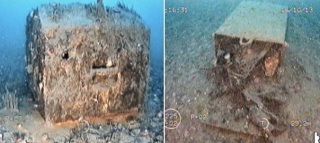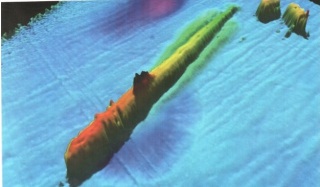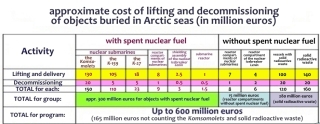
The system built to manage Russia’s nuclear legacy is crumbling, our new report shows
Our op-ed originally appeared in The Moscow Times. For more than three decades, Russia has been burdened with the remains of the Soviet ...
News

Publish date: September 23, 2014
Written by: Anna Kireeva, Charles Digges
News
ARKHANGELSK – Spent nuclear fuel and radioactive waste sunken in Russia’s Arctic seas are in close proximity to prospective sites for oil and gas recovery, into which Russian and other oil majors are rushing – setting a stage for turning irresponsible hydrocarbon drilling in polar oceans into a double nightmare.
There as yet remains no plan for the radioactive rehabilitation of the ocean sites of these potentially dangerous radioactive finds, nor is there any bureaucracy in the Russian government willing to take responsibility for the nuclear trash.
According to the Nuclear Safety Institue of the Russian Academy of Sciences (IBRAE in its Russian acronym), interest in securing undersea radiological safety has been determined by expanded oil and gas field opportunities in the central part of the Kara Sea, where nuclear rubbish like spent nuclear fuel, solid radioactive waste have been found at distances ranging from 10 to 100 kilometers from hydrocarbon exploration and subsequent recovery areas.
That the Kara Sea is essentially an aquarium of radioactive junk was revealed by Bellona two years ago, to the consternation of big oil and its reckless ambitions for drilling the Arctic.
Vessels of solid radioactive waste
Altogether, the Novaya Zemlya Trench off the Arctic Novaya Zemlya archipelago, not far from hydrocarbon exploration, is home to five submarines classified as solid radioactive waste that are sunk at depths of up to 300 meters. These include the vessels Leopard, Molgilev, Jose Diaz, Sayani, Kureika, and a nuclear submarine reactor still packed with its spent nuclear fuel.
According to IBRAE senior researcher Valery Osminov, between now and 2040 the structural stability of the thin-walled outer compartments of the reactors of these vessels, as well as the other barges and pontoons filled with solid radioactive waste, will begin to give way. This will expose the inside of their reactors to sea-water as pinholes in the bulkheads begin to form and corrode the external surfaces of the nuclear power installations.
“The appearance of radionuclides outside the flooded vessels loaded with solid radioactive waste can be expected by 2020 to 2030,” Osminov told the 10th Socio-Environmental Congress in Arkhangelsk. “Intense output will begin in 2060 to 2080 and will be completed by 2100 to 2150.”
As a consequence, he continued, the vessels need to be raised no later than 2030 to 2050.
Osminov predicted that, should the vessels be allowed to lie, the 10 millimeter bulkheads around their reactors would be destroyed throughout 2080 to 2160, allowing sea water to freely wash though the reactors. At the same time, protective barriers around the submarine reactors would lose their mounting integrity and the reactors would capsize.

This would increase the likelihood of a mechanical disruption to their cooling circuits, Osminov continued. Nevertheless, he was somewhat optimistic in saying that the reactor compartments could remain solid even if shot throughout with corrosion holes could still maintain their integrity through around the years 2200 to 2250.
International expeditions
As concerns the containers of solid radioactive waste sunk in the Kara Sea, some 4000 of the 17,000 identified to be lying at sea bottom are identified as being in poor condition – and the number of those in poor condition only increases with time.
Osminov said that experts from the International Atomic Energy Agency (IAEA) and the European Union who assessed the ecological consequences of dumping radioactive waste from Russia’s Navy and nuclear icebreaker fleet concluded that any further impact to the population and biota were negligible.
Norwegian and Russian scientists who have also conducted long-term observation of the waste have likewise concluded that it poses no special risk and can for a certain time remain at sea bottom. However, because of the high potential dangers of certain specific pieces of radioactive waste, especially those with spent nuclear fuel, the Norwegian-Russian team recommends ongoing radiological monitoring around the sunken trash.
The radio-ecological condition of the areas where the nuclear waste was sunk has been described as satisfactory. Expeditions have observed only localized contamination of bottom sediments near containers. But it has taken more than 40 expeditions – including 10 international ones – to reach that sanguine conclusion.
This method of monitoring the conditions of the most dangerous abandoned waste – that which contains spent nuclear fuel – needs to be implemented on a regular basis in the future, as corrosion and failure of protective reactor barriers will continue for the next 500 to 700 years.
Additionally calculations on the rate of corrosion of protective barriers aboard submerged nuclear reactors and other radioactive debris reached by IBRAE suggest that certain circumstances can accelerate the corrosion process, leading to their destruction much earlier than expected.
The K-27 submarine

Information revealed in the course of recent work on unloading nuclear fuel from liquid metal cooled submarine reactors, as well as calculations carried out by physicists and the Leypunsk institute, indicated that in certain cases water ingress into the reactor of the scuttled K-27 submarine, which was dumped under 50 meters of water in Novaya Zemlya’s Stepnovogo Bay, could lead to an uncontrolled chain reaction.
This would lead to the destruction of all protective barriers around the reactor and a significant release of radioactivity into the environment.
Alexander Nikitin, chairman of the Environmental Rights Center (ERC) Bellona, decisions on raising and dismantling the K-27 and other scuttled nuclear subs must be made as soon as possible.
“We have a window of five years to solve the K-27 problem, while the base at Gremikha remains open,” said Nikitin. “Otherwise, we will lose the appropriate infrastructure.”
IBRAE said sunken objects containing spent nuclear fuel and solid radioactive waste can be divided into three degrees of danger to the environment and human health, the first of which is about 10 times greater than the second and about 100 times greater than the third. The first group includes radioactive dumps like the K-27, which contain spent nuclear fuel, the second, those containing solid radioactive waste, the third, reactor that contain no spent nuclear fuel.
Who is responsible?
“We have at the moment a paradoxical situation,” said Osminov. “Russia has no defined bureaucracy answering for these installations, in accordance with which not a single agency is prepared to take the decision of what to do with these hazards upon itself.”

Russia’s Ministry of Defense, the Ministry of Emergency Situations, the Ministry of Natural Resources, the Russian state nuclear corporation Rosatom, and other agencies have already trumpeted the necessity of solving this pressing problem. They even tasked whoever they would find to develop a plan of action for dealing with sunken radiological hazards.
But nothing has been done.
“At present there is no single generally accepted opinion about what needs to be done with these submerged objects,” and IBRAE specialist told Bellona. “Lift them and dismantle them, conserve them at the bottom, or leave them as they are – there is no common understanding of the resources and time required to solve the problem regardless of what you chose.”

Our op-ed originally appeared in The Moscow Times. For more than three decades, Russia has been burdened with the remains of the Soviet ...

The United Nation’s COP30 global climate negotiations in Belém, Brazil ended this weekend with a watered-down resolution that failed to halt deforest...

For more than a week now — beginning September 23 — the Zaporizhzhia Nuclear Power Plant (ZNPP) has remained disconnected from Ukraine’s national pow...

Bellona has taken part in preparing the The World Nuclear Industry Status Report 2025 and will participate in the report’s global launch in Rome on September 22nd.